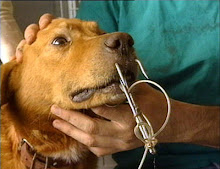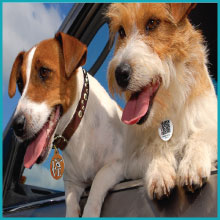The AAVMC Salutes the Canine Heroes Who Served the Country at Home and at War - and the Veterinarians Who Continue To Keep Them Healthy
Dr. Bess Pierce at VMRCVM is one such veterinarian
On Veteran's Day, Nov. 11, it's timely to consider that it's not only humans who serve in our nation's military. There are also more than 2,500 military working dogs (MWDs) on duty worldwide and Colonel Bess Pierce, DVM, DABVP, DACVIM, associate professor at the Virginia-Maryland Regional College of Veterinary Medicine (VMRCVM), is one of the veterinarians responsible for their care. MWDs train alongside soldiers, sailors, airmen, and Marines; they also might parachute out of planes and accompany Special Forces soldiers on dangerous and secret missions.
Photo by the PR Newswire
It's a career that aligns well with Dr. Pierce's long-held interest in canine sports medicine and conditioning for all working dogs, either as a part of their intense physical conditioning or for rehabilitation of injuries.
Pierce explains that, in addition to fulfilling their roles as military service dogs, canines work closely with law enforcement agencies and the Transportation Safety Administration to detect drugs or explosives. Almost all working dogs receive scent training and assignments might include everything from a presidential detail to search and rescue or border patrol, with most dogs involved in explosives detection. Pierce says that working dogs are capable of tracking target odors for either an object or a person, and that the lowest known level of a scent tag detected by a dog is 500 parts per trillion.
After graduating with a doctor of veterinary medicine degree (DVM) from Auburn University in 1992, Pierce joined the Army Veterinary Corp, which is responsible for military dogs' veterinary medical care and conditioning across all branches of the military. During the 15 years she spent on active duty, Pierce worked with MWDs in many parts of the world and, from 2003 to 2006, served as chief of internal medicine at the Department of Defense Military Working Dog Veterinary Service (DODMWDVS) at Lackland Air Force Base, Texas. Since then, the veterinary facilities have expanded into an area known as "Dog Center" at Lackland, where Veterinary Corp officers (VCOs) work closely with a U.S. Air Force unit that is primarily responsible for the dogs' training. Now a colonel in the U.S. Army Reserve, Pierce works with military canines as the reserve director of the DODMWDVS at the Holland Military Dog Working Hospital, a "state-of-the-art facility that offers every possible treatment," where she also helps establish and maintain policy related to U.S. military working dogs worldwide. At the same time, in her civilian job as a VMRCVM faculty member, Pierce and the community practice team provide care for a variety of working and service dogs.
Dr. Pierce explains that the military screens and chooses working dogs in a manner akin to how it chooses elite soldiers, selecting those with suitable temperaments and physical characteristics. They're looking for healthy, athletic dogs that are not fearful or easily startled. The dogs also need to have a particularly acute sense of smell and demonstrate that they have the heart and the drive to work hard. "These dogs love to work and they're miserable when they don't have a job to do," she says.
About 26 percent of working dogs are Belgian Malinois, about 46 percent are German shepherds, and the remaining are Labrador Retrievers, German short-haired pointers or other breeds. Malinois are particularly favored for military missions that require high maneuverability and heat tolerance. Malinois have a "legendary work capacity and drive," says Pierce, and their lean body mass makes them light and portable. "They're long and lean, like marathon runners."
In the past, working dogs were primarily assigned to teams or units with rotating handlers, but today's trend is to pair dogs with single handlers and deploy as a team, she says, depending on the dog's function. "We try to match personalities. Like with any relationship sometimes it works and sometimes it doesn't. When it does work, the dogs and their handlers often form a very intense bond."
With so much time and training invested in the dogs, it makes sense to keep working dogs as healthy as possible. Consequently, in her role, Dr. Pierce practices some of the most advanced veterinary medical care available. "We owe it to (the dogs) for their service," she says, "and they receive a very high level of preventive and rehabilitative care."
Those who aspire to have a veterinary medical career that involves working with military dogs can consider joining the U.S. Army Veterinary Corps and can apply for the Health Professions Scholarship Program, which offers a competitive scholarship for students who are willing to commit to military service. At the time Pierce attended veterinary medical school, the scholarship program was not available to veterinary students but a fellow Reserve Officer Training Corps (ROTC)-scholarship recipient introduced her to the Veterinary Corps. After being commissioned as a VCO, Pierce specialized in small animal internal medicine through the Long Term Health Education and Training (LTHET) Program, the Army's competitive advanced training program that often includes clinical residencies, pathology residency, doctorates or Masters of Public Health (MPH).
"Vet Corps officers work with military working dogs from day one of their careers, and I had MWDs at every assignment," Pierce says. But she points out that Vet Corp service is about more than animal care and health, with officers also involved in public health and food safety and inspection.
According to Pierce, the best preparation for a student interested in serving the working dog population is to gain a solid foundation in a range of disciplines, including surgery, medicine, radiology, emergency medicine, and dentistry. "While my veterinary college did not have specific training in working and service dog medicine and care, Auburn did provide an excellent foundation in both theory and practical hands-on training that enabled me to successfully apply these skills to working dogs once on duty," she says. Pierce gained the remainder of her training through on-the -job experience, mentoring, and continuing educational opportunities in sports medicine and rehabilitation.
Other opportunities exist in a variety of settings to care for law enforcement and service dogs such as guide dogs or search and rescue dogs; interested students may want to augment their education with education in canine behavior and sports medicine, as well as with on-the-job training through internships or externships.
Dr. Pierce relishes the rewards of her profession. In an essay titled, "In Praise of the Working Dog," she wrote, "I would encourage anyone to embrace the opportunity to become involved whenever possible. There are those who are concerned that dogs are 'forced' into service and unduly stressed. Worry not. When properly trained, managed, and appreciated, the happiest creature in the world is a dog with a job."
A working dog's career usually lasts seven or eight years. In the past, attack-trained military dogs were euthanized at the end of their useful working life if they could not be placed with a state or municipal law enforcement agency. Non-attack trained dogs were routinely adopted. Today, by law, all military working dogs are evaluated for potential adoption and any MWD found suitable for adoption is adopted. Go to www.lackland.af.mil/units/341stmwd/index.asp to learn more about the MWD program and how to adopt a former military working dog.
Note: To view this story online with photos, go to: www.aavmc.org/militarydogveterinarian
The Association of American Veterinary Medical Colleges (AAVMC) is a non-profit membership organization working to protect and improve the health and welfare of animals, people and the environment by advancing academic veterinary medicine. Its members include all 33 veterinary medical colleges in the United States and Canada, nine departments of veterinary science, eight departments of comparative medicine, three veterinary medical education institutions, nine international colleges of veterinary medicine, and five affiliate international colleges of veterinary medicine. On the Web: http://www.aavmc.org
SOURCE Association of American Veterinary Medical Colleges
Wednesday, November 9, 2011
Subscribe to:
Post Comments (Atom)





No comments:
Post a Comment